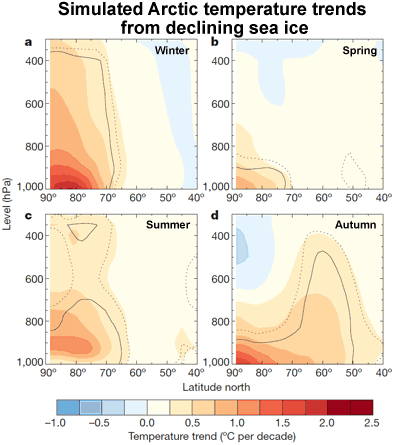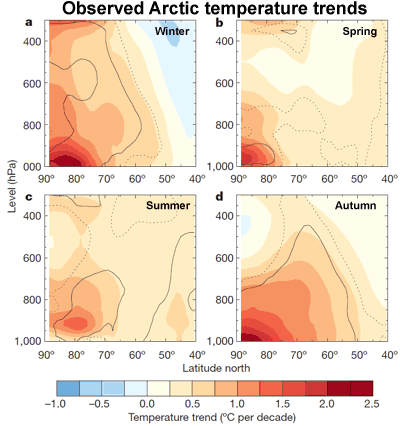 Arguments
Arguments
 Software
Software
 Resources
Comments
Resources
Comments
 The Consensus Project
The Consensus Project
 Translations
Translations
 About
Support
About
Support


Latest Posts
- Skeptical Science New Research for Week #51 2025
- What are the causes of recent record-high global temperatures?
- Fact brief - Are toxic heavy metals from solar panels posing a threat to human health?
- Emergence vs Detection & Attribution
- 2025 SkS Weekly Climate Change & Global Warming News Roundup #50
- Skeptical Science New Research for Week #50 2025
- The rest of the world is lapping the U.S. in the EV race
- Fact brief - Are electromagnetic fields from solar farms harmful to human health?
- Comparing climate models with observations
- 2025 SkS Weekly Climate Change & Global Warming News Roundup #49
- Skeptical Science New Research for Week #49 2025
- Climate Adam & Dr Gilbz - Paris Climate Agreement At 10: Did It Do Anything?
- Fact brief - Does the recent slowdown in Arctic sea-ice extent loss disprove human-caused warming?
- Why the chemtrail conspiracy theory lingers and grows – and why Tucker Carlson is talking about it
- 2025 SkS Weekly Climate Change & Global Warming News Roundup #48
- Skeptical Science New Research for Week #48 2025
- Consensus machines
- Just have a Think - How an African energy revolution could save ALL of us.
- A girl’s grades drop every summer. There’s an alarming explanation.
- 2025 SkS Weekly Climate Change & Global Warming News Roundup #47
- Fact brief - Are changes in solar activity causing climate change?
- Skeptical Science New Research for Week #47 2025
- Exploring newly released estimates of current policy warming
- Climate Adam - Why the Climate Crisis is a Health Crisis
- Super pollutants are trendy, but we should be careful how we use them
- 2025 SkS Weekly Climate Change & Global Warming News Roundup #46
- Skeptical Science New Research for Week #46 2025
- On the Gates climate memo
- Climate Adam - Climate Scientist responds to Bill Gates
- Five ways Joe Rogan misleads listeners about climate change
Archived Rebuttal
This is the archived Intermediate rebuttal to the climate myth "Melting ice isn't warming the Arctic". Click here to view the latest rebuttal.
What the science says...
| Decline in sea ice is the major driver of Arctic amplification. This is evidence by the pattern of atmospheric warming over the Arctic. Maximum warming occurs over the surface during winter while less surface warming is found in summer when heat is b |
The warming trend in the Arctic is almost twice as large as the global average in recent decades. This is known as Arctic amplification. What's the cause? Changes in cloud cover, increases in atmospheric water vapour, more atmospheric heat transport from lower latitudes and declining sea ice have all been suggested as contributing factors. A new paper The central role of diminishing sea ice in recent Arctic temperature amplification (Screen & Simmonds 2010) (here's the full paper) examines this question. The title is a bit of a give-away - the decline in sea ice is the major driver of Arctic amplification.
The vertical profile of Arctic warming (eg - how much warming occurs at different altitudes) gives us insight into the underlying cause. If atmospheric heat transported from lower latitudes was the major driver, more warming would be expected at greater heights. On the other hand, if retreating snow and sea ice cover was the major cause, maximum warming would be expected at the surface. Figure 1 shows the simulated warming expected in each season if declining sea ice was the major cause of warming.

Figure 1: Temperature trends linked to changes in sea ice. Temperature trends over the 1989–2008 period averaged around circles of latitude for winter (a), spring (b), summer (c) and autumn (d). The trends are derived from projections of the temperature field on the sea ice time series.
Using higher resolution temperature data supplemented with updated satellite measurements, Screen 2010 analyse the observe warming trend in each season. What they find is maximum Arctic warming at the surface and that warming lessens with height in all seasons except summer. This vertical structure suggests that changes at the surface, such as decreases in sea ice and snow cover, are the primary causes of recent Arctic amplification.

Figure 2: Observation of temperature trends, 1989–2008. Temperature trends averaged around circles of latitude for winter (December–February; a), spring (March–May; b), summer (June–August; c) and autumn (September–November; d). Red shading indicates that the lower atmosphere has warmed faster than the atmospheric column as whole. Blue shading indicates that the lower atmosphere has warmed slower than the atmospheric column as a whole.
The surface warming is modest in summer because energy is used to melt remaining sea ice and warm the upper ocean. The majority of the winter warming is associated with changes in sea ice cover even though the sea ice declines at this time of the year are relatively small. During summer, the atmosphere loses heat to the ocean whereas during winter, the flux of heat is reversed. Reduced summer sea ice cover allows for greater warming of the upper ocean but atmospheric warming is modest. The excess heat stored in the upper ocean is subsequently released to the atmosphere during winter.
Another potential contributor to amplified warming that's investigated is changes in cloud cover. Spring is the only season that exhibits significant trends in Arctic average cloudiness and the trend is negative. However, decreased cloud cover is expected to cause surface cooling because clouds have a warming influence in spring. Thus no evidence is found of cloud cover changes contributing to recent near-surface Arctic warming.
Changes in atmospheric water vapour content may amplify Arctic warming. However, specific humidity trends are found only during summer and early autumn. The pronounced warming in winter and spring are not accompanied by increases in humidity. In fact, the evidence suggests part of the humidity increase is driven by enhanced surface moisture fluxes associated with sea ice reductions.
The empirical evidence from the past two decades reveals that declining sea ice cover and thickness have been great enough to enhance Arctic warming during most of the year. The emergence of strong ice–temperature positive feedbacks increases the likelihood of future rapid Arctic warming and sea ice decline.
Updated on 2010-06-26 by James Wight.
THE ESCALATOR

(free to republish)
























































